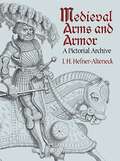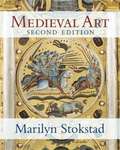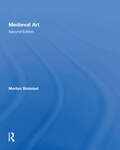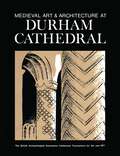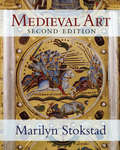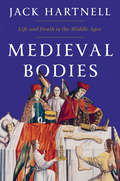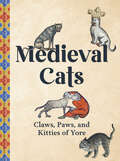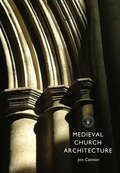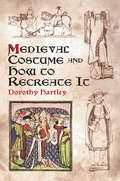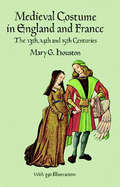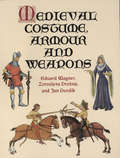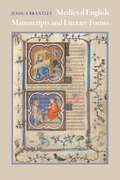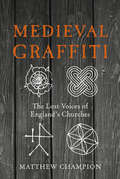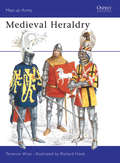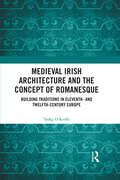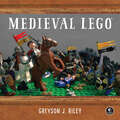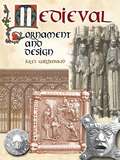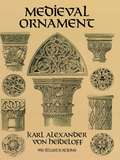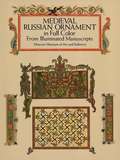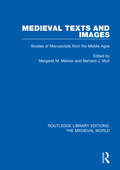- Table View
- List View
Medieninnovationen AR und VR: Erfolgsfaktoren für die Entwicklung von Experiences
by Elle LangerAugmented und Virtual Reality sind Medieninnovationen mit spezifischen Merkmalen. Sie erzeugen beim Nutzer eine Immersion, da der Nutzer in das Medium und seine 360° Umgebung hineintaucht. Um erfolgreich Inhalte und Anwendungen für AR und VR zu entwickeln, müssen psychologische Wirkungsweisen, die Besonderheiten der 360° Umgebung, die Geschichte und die Art der Mediennutzug mit den Bedürfnissen und Erlebnissen des Nutzers abgestimmt werden. Contentproduzenten stellt das vor neuartige Herausforderungen bei der Contententwicklung, der Methodenwahl, der Teamarbeit und dem gesamten Herstellungsprozess von AR und VR Experiences.Das Buch führt den Leser in die Merkmale der immersiven Medien ein und bietet ihm wissenschaftliche Belege und praxisrelevante Tipps, die ihm helfen, hochwertige und nutzerzentrierte Inhalte für die Immersiven Medien zu produzieren. Die wissenschaftlich hergeleiteten Erfolgsfaktoren in Form von Checklisten sind ein Leitfaden und eine ideale Grundlage, um den Herstellungsprozess zu standardisieren und die eigenen Projekte weiterzuentwickeln.
Medieval Arms and Armor: A Pictorial Archive
by J. H. Hefner-AlteneckA renowned 19th-century cultural historian and specialist on the Middle Ages, J. H. Hefner-Alteneck spent much of his life observing the influence of art on many aspects of human life, including weaponry. His illustrations for this handsome archive — drawn with incredible exactitude — depict a wide array of medieval weapons and armor dating from the early ninth century to the mid-1700s.Adapted primarily from decorative ornamentation on burial monuments and manuscripts, hundreds of finely executed images depict authentic shields, swords, crossbows, helmets, and highly ornate suits of body armor for knights and their steeds. Newly translated descriptive notes, extracted from the original German text, identify the subjects. First published more than 100 years ago, this meticulously rendered study remains an invaluable source of permission-free illustrations for artists and designers and an indispensable reference for scholars, collectors, and hobbyists.
Medieval Art
by Marilyn StokstadThis beautifully produced survey of over a thousand years of Western art and architecture introduces the reader to a vast period of history ranging from ancient Rome to the age of exploration. The monumental arts and the diverse minor arts of the Middle Ages are presented here within the social, religious, and political frameworks of lands as varied as France and Denmark, Spain and Turkey. Marilyn Stokstad also teaches her reader how to look at medieval art-which aspects of architecture, sculpture, or painting are important and for what reasons. Stylistic and iconographic issues and themes are thoroughly addressed with attention paid to aesthetic and social contexts. Significantly updated, this second edition of Medieval Art spans the period from the second to the fifteenth centuries.
Medieval Art Second Edition
by Marilyn StokstadThis beautifully produced survey of over a thousand years of Western art and architecture introduces the reader to a vast period of history ranging from ancient Rome to the age of exploration. The monumental arts and the diverse minor arts of the Middle Ages are presented here within the social, religious, and political frameworks of lands as varied as France and Denmark, Spain and Turkey. Marilyn Stokstad also teaches her reader how to look at medieval art-which aspects of architecture, sculpture, or painting are important and for what reasons. Stylistic and iconographic issues and themes are thoroughly addressed with attention paid to aesthetic and social contexts.
Medieval Art and Architecture at Durham Cathedral: The British Archaeological Association Conference Transactions for the year 1977 (The British Archaeological Association Conference Transactions)
by Peter Draper Nicola ColdstreamThis book contains fifteen essays that synthesize the documentary and archaeological evidence for the development of early medieval Durham and asses its archaeological potential. It systematically extracts the important aspects of materials related to architectural history of the Durham cathedral.
Medieval Art in Motion: The Inventory and Gift Giving of Queen Clémence de Hongrie
by Mariah Proctor-TiffanyIn this visually rich volume, Mariah Proctor-Tiffany reconstructs the art collection and material culture of the fourteenth-century French queen Clémence de Hongrie, illuminating the way the royal widow gave objects as part of a deliberate strategy to create a lasting legacy for herself and her family in medieval Paris.After the sudden death of her husband, King Louis X, and the loss of her promised income, young Clémence fought for her high social status by harnessing the visual power of possessions, displaying them, and offering her luxurious objects as gifts. Clémence adeptly performed the role of queen, making a powerful argument for her place at court and her income as she adorned her body, the altars of her chapels, and her dining tables with sculptures, paintings, extravagant textiles, manuscripts, and jewelry—the exclusive accoutrements of royalty. Proctor-Tiffany analyzes the queen’s collection, maps the geographic trajectories of her gifts of art, and interprets Clémence’s generosity using anthropological theories of exchange and gift giving. Engaging with the art inventory of a medieval French woman, this lavishly illustrated microhistory sheds light on the material and social culture of the late Middle Ages. Scholars and students of medieval art, women’s studies, digital mapping, and the anthropology of ritual and gift giving especially will welcome Proctor-Tiffany’s meticulous research.
Medieval Art in Motion: The Inventory and Gift Giving of Queen Clémence de Hongrie
by Mariah Proctor-TiffanyIn this visually rich volume, Mariah Proctor-Tiffany reconstructs the art collection and material culture of the fourteenth-century French queen Clémence de Hongrie, illuminating the way the royal widow gave objects as part of a deliberate strategy to create a lasting legacy for herself and her family in medieval Paris.After the sudden death of her husband, King Louis X, and the loss of her promised income, young Clémence fought for her high social status by harnessing the visual power of possessions, displaying them, and offering her luxurious objects as gifts. Clémence adeptly performed the role of queen, making a powerful argument for her place at court and her income as she adorned her body, the altars of her chapels, and her dining tables with sculptures, paintings, extravagant textiles, manuscripts, and jewelry—the exclusive accoutrements of royalty. Proctor-Tiffany analyzes the queen’s collection, maps the geographic trajectories of her gifts of art, and interprets Clémence’s generosity using anthropological theories of exchange and gift giving. Engaging with the art inventory of a medieval French woman, this lavishly illustrated microhistory sheds light on the material and social culture of the late Middle Ages. Scholars and students of medieval art, women’s studies, digital mapping, and the anthropology of ritual and gift giving especially will welcome Proctor-Tiffany’s meticulous research.
Medieval Art: Medieval Art (Icon Editions)
by Marilyn StokstadThis beautifully produced survey of over a thousand years of Western art and architecture introduces the reader to a vast period of history ranging from ancient Rome to the age of exploration. The monumental arts and the diverse minor arts of the Middle Ages are presented here within the social, religious, and political frameworks of lands as varied as France and Denmark, Spain and Turkey. Marilyn Stokstad also teaches her reader how to look at medieval art-which aspects of architecture, sculpture, or painting are important and for what reasons. Stylistic and iconographic issues and themes are thoroughly addressed with attention paid to aesthetic and social contexts. Significantly updated, this second edition of Medieval Art spans the period from the second to the fifteenth centuries and includes over 4000 illustrations, over 100 in color, detailed maps, a time-line, glossary, bibliography, and index-all in a larger 8 by 10 inch trim size.
Medieval Bodies: Life And Death In The Middle Ages (Wellcome Collection)
by Jack HartnellWith wit, wisdom, and a sharp scalpel, Jack Hartnell dissects the medieval body and offers a remedy to our preconceptions. Just like us, medieval men and women worried about growing old, got blisters and indigestion, fell in love, and had children. And yet their lives were full of miraculous and richly metaphorical experiences radically different from our own, unfolding in a world where deadly wounds might be healed overnight by divine intervention, or where the heart of a king, plucked from his corpse, could be held aloft as a powerful symbol of political rule. In this richly illustrated and unusual history, Jack Hartnell uncovers the fascinating ways in which people thought about, explored, and experienced their physical selves in the Middle Ages, from Constantinople to Cairo and Canterbury. Unfolding like a medieval pageant, and filled with saints, soldiers, caliphs, queens, monks and monstrous beasts, this book throws light on the medieval body from head to toe—revealing the surprisingly sophisticated medical knowledge of the time. Bringing together medicine, art, music, politics, philosophy, religion, and social history, Hartnell's work is an excellent guide to what life was really like for the men and women who lived and died in the Middle Ages. Perfumed and decorated with gold, fetishized or tortured, powerful even beyond death, these medieval bodies are not passive and buried away; they can still teach us what it means to be human. Some images in this ebook are not displayed due to permissions issues.
Medieval Cats: Claws, Paws, and Kitties of Yore
by Catherine NappingtonA hilarious celebration of cats in artwork from medieval times.Look what the cat dragged in from the Middle Ages—a curious compendium of cats unlike any you&’ve ever lapped up before.For more than a millennium, a myriad of medieval manuscripts and artworks painted a picture of cats as playful and curious but also lazy, selfish, and vicious. Today, these masterpieces live on, shining a bright light on the dark age of cats and telling a hilarious story of their paw-some glory. From bum-licking to cat-fighting to mouse-tricking, Medieval Cats is a hilarious celebration of cats who are up to no good.Learn cat facts from the Middle Ages and the origins of cat proverbs, and discover poems and excerpts from literature that mention cats. Both humor book and peek into medieval art, Medieval Cats is for cat lovers—and haters—everywhere!
Medieval Church Architecture
by Jon CannonBy the end of the medieval period, Britain's churches already had an architectural heritage of one thousand years, much of which remains on view today. This guide by architectural historian Jon Cannon uses high-quality photographs and diagrams to help us to analyze the leading changes in style from the Anglo-Saxon period, through the Romanesque as far as Gothic and Perpendicular. By identifying various clues left by each period, he enables us to date architectural features and styles, and explains the technical terms applied to them. If you have ever wondered how your church or cathedral developed, and want to know your triforium from your blind arcade or your vault from your hammerbeam, all the answers are here.
Medieval Costume and How to Recreate It (Dover Pictorial Archive Ser.)
by Dorothy HartleyThis unique reference classifies the clothes and accessories of the 12th through the 15th centuries along social lines. Garments of every type, from the wardrobes of peasants and nobility, appear in over 200 period illustrations and patterns. Helpful advice covers: choosing fabrics, placement of seams, draping and folding garments, more. 203 black-and-white illustrations.
Medieval Costume in England and France: The 13th, 14th and 15th Centuries (Dover Pictorial Archive Ser.)
by Mary G. HoustonThis carefully researched volume offers lovers of both costume and the medieval period a meticulously researched and accurately detailed study of the clothing of the Middle Ages. Following an illuminating discussion of the style and construction of costumes worn in the thirteenth, fourteenth, and fifteenth centuries, noted costume historian Mary G. Houston provides detailed descriptions and illustrations of actual apparel worn by all classes and sectors of society. Included are elaborate royal, academic, and legal costumes; Eucharistic vestments and garments of religious orders; working class apparel; civilian dress; and more. Also examined is a wide variety of accessories and ornaments, jewelry, armor, textiles, embroidery, coiffures, and other items.The clear, succinct text is splendidly documented by 350 black-and-white line illustrations based on contemporary books and manuscripts as well as representations in paintings and sculpture. Indispensable for students of costume history, medievalists, illustrators, and fashion historians, Medieval Costume in England and France will delight anyone interested in the medieval period and its dress.
Medieval Costume, Armour and Weapons (Dover Fashion and Costumes)
by Zoroslava Drobná Eduard Wagner Jan DurdíkAccompanied by a scrupulously researched and well-documented text, over 400 royalty-free illustrations trace the evolution of clothing styles, armor, and weapons during the medieval period in Central Europe -- from simple tunics and robes of peasants to the battle equipment and armor of warriors and the fur-lined cloaks and brocaded garments of the aristocracy.
Medieval English Manuscripts and Literary Forms (Material Texts)
by Jessica BrantleyIn Medieval English Manuscripts and Literary Forms, Jessica Brantley offers an innovative introduction to manuscript culture that uses the artifacts themselves to open some of the most vital theoretical questions in medieval literary studies. With nearly 200 illustrations, many of them in color, the book offers both a broad survey of the physical forms and cultural histories of manuscripts and a dozen case studies of particularly significant literary witnesses, including the Beowulf manuscript, the St. Albans Psalter, the Ellesmere manuscript of the Canterbury Tales, and The Book of Margery Kempe. Practical discussions of parchment, scripts, decoration, illustration, and bindings mix with consideration of such conceptual categories as ownership, authorship, language, miscellaneity, geography, writing, editing, mediation, illustration, and performance—as well as of the status of the literary itself.Each case study includes an essay orienting the reader to particularly productive categories of analysis and a selected bibliography for further research. Because a high-quality digital surrogate exists for each of the selected manuscripts, fully and freely available online, readers can gain access to the artifacts in their entirety, enabling further individual exploration and facilitating the book’s classroom use. Medieval English Manuscripts and Literary Forms aims to inspire a broad group of readers with some of the excitement of literary manuscript studies in the twenty-first century. The interpretative frameworks surrounding each object will assist everyone in thinking through the implications of manuscript culture more generally, not only for the deeper study of the literature of the Middle Ages, but also for a better understanding of book cultures of any era, including our own.
Medieval Graffiti: The Lost Voices of England's Churches
by Matthew ChampionA fascinating guide to decoding the secret language of the churches of England through the medieval carved markings and personal etchings found on our church walls from archaeologist Matthew Champion.'Rare, lovely glimmers of everyday life in the Middle Ages.' -- The Sunday Times'A fascinating and enjoyable read' -- ***** Reader review'Superb' -- ***** Reader review'Riveting' -- ***** Reader review'Compelling, moving and fascinating' -- ***** Reader review*****************************************************************************************************Our churches are full of hidden messages from years gone by and for centuries these carved writings and artworks have lain largely unnoticed.Having launched a nationwide survey to gather the best examples, archaeologist Matthew Champion shines a spotlight on a forgotten world of ships, prayers for good fortune, satirical cartoons, charms, curses, windmills, word puzzles, architectural plans and heraldic designs.Here are strange medieval beasts, knights battling unseen dragons, ships sailing across lime-washed oceans and demons who stalk the walls. Latin prayers for the dead jostle with medieval curses, builders' accounts and slanderous comments concerning a long-dead archdeacon.Strange and complex geometric designs, created to ward off the 'evil eye' and thwart the works of the devil, share church pillars with the heraldic shields of England's medieval nobility.Giving a voice to the secret graffiti artists of Medieval times, this engaging, enthralling and - at times - eye-opening book, with a glossary of key terms and a county-by-county directory of key churches, will put this often overlooked period in a whole new light.
Medieval Heraldry
by Terence Wise Richard HookCoats of arms were at first used only by kings and princes, then by their great nobles, but by the mid-13th century arms were being used extensively by the lesser nobility, knights and those who later came to be styled gentlemen. In some countries the use of arms spread even to merchants, townspeople and the peasantry. From the mundane to the fantastic, from simple geometric patterns to elaborate mythological beasts, this fascinating work by Terence Wise explores the origins and appearance of medieval heraldic devices in an engagingly readable style accompanied by numerous illustrations including eight full page colour plates by Richard Hook.
Medieval Irish Architecture and the Concept of Romanesque: Building Traditions in Eleventh- and Twelfth-Century Europe
by Tadhg O’KeeffeThis book presents a fresh perspective on eleventh- and twelfth-century Irish architecture, and a critical assessment of the value of describing it, and indeed contemporary European architecture in general, as “Romanesque”. Medieval Irish Architecture and the Concept of Romanesque is a new and original study of medieval architectural culture in Ireland. The book’s central premise is that the concept of a “Romanesque” style in eleventh- and twelfth-century architecture across Western Europe, including Ireland, is problematic, and that the analysis of building traditions of that period is not well served by the assumption that there was a common style. Detailed discussion of important buildings in Ireland, a place marginalised within the “Romanesque” model, reveals the Irish evidence to be intrinsically interesting to students of medieval European architecture, for it is evidence which illuminates how architectural traditions of the Middle Ages were shaped by balancing native and imported needs and aesthetics, often without reference to Romanitas. This book is for specialists and students in the fields of Romanesque, medieval archaeology, medieval architectural history, and medieval Irish studies.
Medieval Irish Architecture and the Concept of Romanesque: Building Traditions in Eleventh- and Twelfth-Century Europe
by Tadhg O’KeeffeThis book presents a fresh perspective on eleventh- and twelfth-century Irish architecture, and a critical assessment of the value of describing it, and indeed contemporary European architecture in general, as “Romanesque”.Medieval Irish Architecture and the Concept of Romanesque is a new and original study of medieval architectural culture in Ireland. The book’s central premise is that the concept of a “Romanesque” style in eleventh- and twelfth-century architecture across Western Europe, including Ireland, is problematic, and that the analysis of building traditions of that period is not well served by the assumption that there was a common style. Detailed discussion of important buildings in Ireland, a place marginalised within the “Romanesque” model, reveals the Irish evidence to be intrinsically interesting to students of medieval European architecture, for it is evidence which illuminates how architectural traditions of the Middle Ages were shaped by balancing native and imported needs and aesthetics, often without reference to Romanitas.This book is for specialists and students in the fields of Romanesque, medieval archaeology, medieval architectural history, and medieval Irish studies.
Medieval LEGO
by Greyson BeightsMedieval LEGO takes you through real English history in the middle ages with a unique twist, with every event illustrated by a tiny little LEGO scene. With contributions by medievalists and scholars, this book brings medieval history to life in a fun, kid-friendly way.Inside, you'll learn about events like the Battle of Hastings, the chartering of Oxford University, and the signing of the Magna Carta. You'll witness the infamous Black Death, and the Great Famine, and you'll read about famous historical figures like Robin Hood, Richard the Lionheart, Geoffrey Chaucer, and William the Conqueror.Grab your broadsword and turn the page to join the adventure.
Medieval Ornament and Design
by Jules GailhabaudThis lavish archive of exquisite engravings and designs--originally created in the mid-nineteenth century for the professional artist and architect--contains some 200 splendid illustrations, expertly adapted from decorative as well as utilitarian features of medieval cathedrals, churches, tombs, houses, shops, public buildings, and other structures. Encompassing a wide variety of styles, the designs include finely detailed panels, gawking gargoyles, marvelously carved pillars and pedestals, exquisite ironwork patterns, decorative stonework, magnificent stained glass windows, moldings enhanced with intricately woven motifs, and much more.Artists, designers, and craftworkers will find wide use for these versatile, royalty-free illustrations. Students of architecture, art historians, and lovers of ornamental art will delight in the pure beauty of this magnificent collection.
Medieval Ornament: 950 Illustrations (Dover Pictorial Archive)
by Karl Alexander HeideloffThe decorative arts of the Middle Ages -- richly ornate, filled with religious and mythic symbolism -- were especially remarkable for the complexities of their design and their inspired craftsmanship. This fascinating volume presents nearly 1,000 illustrations of medieval ornament, consisting mostly of architectural elements from German Romanesque and Gothic churches and other buildings.Originally compiled by the German architect, painter, and engraver Karl Alexander von Heldeloff (1788-1865) as a source of study and inspiration for practicing artists and architects, this grand pictorial archive has been exactingly reproduced from a rare original edition, complete with new English translations of the German captions.The book is filled with precisely detailed engravings of doors, windows, decorative stonework, columns, pedestals, and more. It remains a richly varied resource of authentic images of medieval ornament, ideal for students of architecture and the decorative arts and essential for graphic artists and designers in search of royalty-free illustrations.
Medieval Russian Ornament in Full Color: From Illuminated Manuscripts (Dover Pictorial Archive)
by Moscow Museum of ArtThis beautiful book illustrates the splendid ornamental lettering and decorative art in illuminated Russian manuscripts dating from the 10th through the 16th centuries. It contains over 1,000 motifs reprinted in full color from a rare book of design first published in France in 1870. Among the designs are richly embellished letters from the Cyrillic and Greek alphabets, elaborate manuscript page heads and ornate corners and borders. Many of the designs incorporate mythological creatures, religious iconography, and design elements deeply rooted in early Slavic and Byzantine cultures. There is a strong Celtic flavor as well. On page after page, the distinctive motifs in this collection reflect the unique heritage of Russian design, a rich amalgam of East and West. Students of graphic design and the decorative arts will find the book an invaluable reference. Graphic artists will find these rare, copyright-free examples of medieval ornament, which lend themselves to color copying, ideal for many kinds of projects.
Medieval Texts and Images: Studies of Manuscripts from the Middle Ages (Routledge Library Editions: The Medieval World #32)
by Margaret M. Manion Bernard J. MuirOriginally published in 1991, Medieval Texts and Images is a collection of essays which critically examines medieval manuscripts. The book contains a wide range of contributions, the first examines the relationship of the Légende Dorée and its relationship to the aristocratic patrons who commissioned these manuscripts; the second scrutinises the tradition of French illumination as it was developed in Paris in the so-called Bedford Master’s workshop in the 1420s. The text examines liturgical texts of the medieval period and written and liturgical contributions to Renaissance art. Other contributions include an investigation into the written scroll within the painted composition, comparing various compositional and thematic functions in the depiction of a Crucifixion and a study of Christian vernacular poetry. This collection provides a comprehensive overview of the use of text and image in medieval literature.
Medieval Theatre in Context: An Introduction
by John HarrisFirst Published in 1992. Routledge is an imprint of Taylor & Francis, an Informa company.

